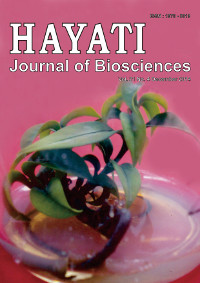Nutritional Content of Artemia sp. Fed with Chaetoceros calcitrans and Skeletonema costatum
Abstract
Artemia sp. is a natural food with high protein content, especially amino acid. Nowadays, Indonesia still relies on import for its supply. Hence, the utilization of local Artemia sp. as an alternative to the imported product is recommended as it contains more protein and less expensive. The advantages of local Artemia sp. is its better crystal quality as it is still fresh. It also provides better income for salt farmers because waste water from salt farm can be used to culture Artemia sp.. This research is aimed at determining the quality of locally-produced Artemia sp., by evaluation of its essential amino acid and fatty acid profiles after treatments. Our results indicated that Artemia sp. cysts with good quality were produced after 8 hours and Artemia sp. reaches a hatching rate of 1,320,000 cysts (95%) after 27 hours. We also found an indication that the best feed concentration was a mix of 60% Chaetoceros calcitrans with 40% Skeletonema costatum. Fatty acid profile analyses showed that the highest SAFA (12.86%) and PUFA (29.91%) were gained after feeding with Chaetoceros calcitrans, whereas the highest HUFA (4.93%) was gained after feeding with Skeletonemacostatum. Essential amino acid profile analyses revealed the highest content of amino acid (18912.62 ppm) was after feeding with a combination of Chaetoceros calcitrans and Skeletonema costatum. Finally, the proper water quality during research was at 25-30 oC of temperature, 30-31 ppt of salinity, pH 7.8-8.9, and DO was at 3.0-4.4 mg/L.Downloads
HAYATI J Biosci is an open access journal and the article's license is CC-BY-NC. This license lets others distribute, remix, tweak, and build upon author's work, as long as they credit the original creation. Authors retain copyright and grant the journal/publisher non exclusive publishing rights with the work simultaneously licensed under a https://creativecommons.org/

























.png) IPB University
IPB University Department of Biology
Department of Biology The Indonesian Biological Society
The Indonesian Biological Society 

